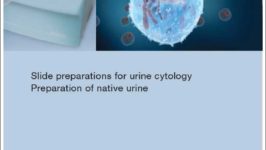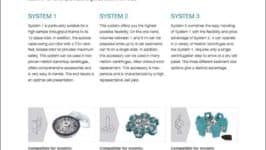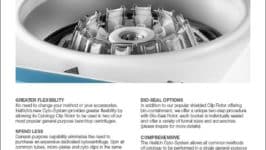Urine Cytology Application Note
This application note provides information on specific application methods and the use of Hettich products. (more…) read more...
File size: 208.3 kb
To derive a good cytological preparation from a urine sample, it is not sufficient to centrifuge native urine onto commercial microscope slides. Urine has a low cell concentration, and those cells present adhere poorly to the slides. This would result in preparation with an insufficient cell concentration. To increase the cell concentration, it is necessary to coat the slide or use a suitable fixative. Poly-L-Lysine (PLL, Sigma, Cat. No. P8920) is ideal for slide coating and Saccomano’s solution for fixing. Hettich centrifuges can be used to perform this application.
A) Preparation of a cytological specimen with coated slides
1. Preparation of the slide
Two methods are available for the coating of the slides with PLL – the immersion method and coating in the centrifuge. The immersion method is simple and easy to use, but the coating is occasionally not uniform. Coating in a centrifuge is a more time-consuming procedure, but will always deliver excellent results.
a) Immersion method
Dilute PLL 1:10 with distilled water and fill it into a cuvette.
Immerse commercial slides into this solution without any pre-treatment and leave them in the solution for5 minutes. The PLL should be at room temperature.
Remove the slides and dry them flat in a heated cabinet at approximately 60 °C. It will take longer to dry them at room temperature. The slides are ready to use as soon as the PLL layer is dry.
b) Coating in the centrifuge
• Dilute the PLL 1:10.
• Lay the uncleaned slides on the slide carrier (Cat. No. 1662) and secure an 8 ml chamber to it (Cat. No. 1666).
• Fill 100 µl diluted PLL into the cyto chamber.
• Centrifuge the cyto insert at 1100 x g for one hour (corresponds to 3,000 min-1 with the 6-place rotor and 3,200 min-1 with the 4-place rotor. The sample can then be filled directly into the cyto chamber.
2. Suitable accessories
For centrifugation of urine, we recommend the use of our largest cyto chamber with a volume of 8 ml and a sedimentation area of 240 mm2. In many cases, this will avoid the need for pre-centrifugation in tubes.
3. Assembly of the cyto insert
Information on the assembly of the cyto insert is provided in our leaflet “Perfect preparations – with the Hettich cyto system all it takes is a turn.” For slide preparations from urine, it is generally necessary to use wet fixation. The cyto insert should, therefore, be assembled without the filter card (see A1 in the illustration). If the specimens are infectious, then we recommend the use of our lid No. 1661 (see A2 in the leaflet).
4. Centrifugation
a) Sedimentation
• Centrifuge the cyto chambers for 5 minutes at 1100 x g (corresponds to 3,000 min-1 with the 6-place rotor and 3,200 min-1 with the 4-place rotor.
b) Removal of the cell-free supernatant
• The cell-free supernatant remains in the chamber after centrifugation and is removed by careful decanting or pipetting. It is important that the sediment is not disturbed whilst the supernatant is being removed, as this can affect the quality of the procedure and lead to cell loss.
c) Fixing and staining
• Once the supernatant has been removed the moist preparation can be fixed immediately (e.g., in 99% ethanol) and then stained.
B) Preparation of a cytological specimen using Saccomano’s solution
1. Preparatory steps
a) Preparation of the urine sample
• Centrifuge the urine sample in a tube for 10 minutes at 1700 x g (3,600 min-1 with the 6-place rotor and 4,000 min-1 with the 4-place rotor).
• Decant the supernatant.
Important: The sediment in the centrifuge tube must be loosened before the addition of the Saccomano’s solution (best achieved through lightly tapping the base of the tube against a solid surface).
• Add the Saccomano’s solution and allow it to stand for 30 minutes at room temperature.
b) Preparation of the Saccomano’s solution
To prepare 100 ml of Saccomano’s solution, mix 43 ml distilled water, 53 ml 95 % ethanol, and 4 ml polyethylene glycol (PEG) stock solution.
c) Preparation of the polyethylene glycol stock solution:
• Heat polyethylene glycol 1500 (Merck Darmstadt, Cat. No. 807489) and distilled water to 60 °C.
• The same volume of each (e.g., 50 ml PEG and 50 ml distilled water) is warmed and mixed.
• Allow the stock solution to cool to room temperature before the Saccomano‘s solution is made up.
2. Suitable accessories
See section A) 2.
3. Assembly of the cyto insert
See section A) 3.
4. Centrifugation
a) Sedimentation
The cyto chambers are centrifuged for 5 minutes at 1100 x g (corresponding to 3,000 min-1 with the 6-place rotor and 3,200 min-1 with the 4-place rotor).
b) Removal of the cell-free supernatant
The cell-free supernatant remains in the chamber after centrifugation and is removed by decanting.
c) Fixing and staining
After removal of the supernatant, remove the cyto chamber and allow the sediment to air-dry until a wax-like deposit has formed. The preparation may be mailed out in this state. Before staining, the wax-like deposit on the sediment must be removed through immersion in 50% ethanol for approx. 10 minutes.
Hettich products are designed to help you achieve optimal results for your application and are built to perform to the specifications outlined in the operators manual. For application-specific information and settings, please refer to your organization’s standard operating procedure. As always, our Hettich representatives are here to help determine which Hettich products and accessories best fit your laboratory requirements.

This application note provides information on specific application methods and the use of Hettich products. (more…) read more...

This brochure provides information on the Hettich Cyto System rotors and accessories. (more…) read more...

This product sheet provides a detailed overview of the product features, benefits and models. (more…) read more...
Hettich manufactures centrifuges for any standard laboratory application.